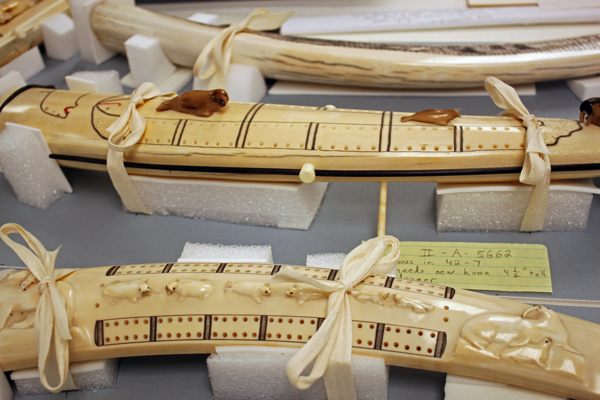
Construction workers in Juneau are making progress on the State Library Archives Museum building – otherwise known as SLAM. What most people don’t see is all the work behind the scenes.
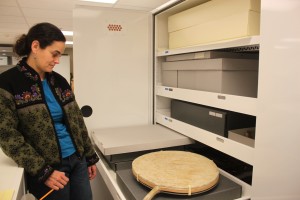
A small team of museum staff members, volunteers and museum professionals from around the state are packing up the Alaska State Museum’s entire collection – ranging from a 45-foot umiak to half-inch-tall ivory pieces.
Only 5 percent of the museum’s collection is displayed at any given time. The rest is stored in the basement.
Lisa Phu took a tour of the museum basement to find out what it takes to move a museum.
As conservator for the Alaska State Museum, Ellen Carrlee is responsible for figuring out how to pack up more than 32,000 objects. This involves opening every drawer in every storage unit and coming up with a plan for each item.

“Like this drawer for example has several boxes in it already which are really easy to travel, but this drum which is from the Arctic Winter Games; it’s a walrus stomach drum from 1974 and it has signatures of people all over,” Carrlee said. “It’s very delicate.”
Carrlee says she and other museum staff members pack and move objects all the time – for exhibits or to go on loan – that’s part of their job description. But moving an entire collection usually happens only once in someone’s career.
There’s no manual on how to pack up a museum collection, so Carrlee resorted to more pedestrian means – she Googled it.
“If you look on the internet for good methods for packing museum artifacts, and you try to search Google images or whatever, you’d think there’d be a lot of images but there’s not nearly as many as we’d like to see,” Carrlee said.
So they’ve had to improvise. Carrlee has come up with about a dozen different techniques for packing various artifacts, including dance fans with feather appendages, ivory cribbage boards, spruce root baskets, a three-foot high piece of red tree coral.
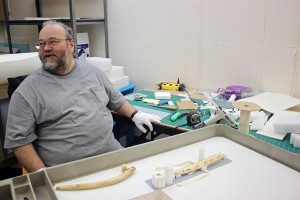
She walks around with a yellow legal pad, scrutinizes each artifact and writes down a plan to stabilize it. After she’s gone through all the objects, she tapes her handwritten notes and diagrams to the outside of the cabinet.
“Every cabinet, every drawer, every item has to have a plan,” she said.
Carrlee heads up a team of staff and volunteers who are tackling different aspects of the packing.
On this day, museum professional Jon Loring is focused on ivory. He wears cotton gloves and is in the process of making custom storage mounts for carved ivory pipes.
“Ivory is one of the most fragile objects in the collection,” he said.

Loring sits by a table filled with cutting materials, measuring devices, a glue gun, a spool of cotton ribbon, and different size scraps of foam and cardboard.
“Some of these are really complicated and you have to cut exactly the right angle to support the object and it’s not so easy,” Loring said. “I can probably do about 12-15 of these a day.”
The museum has 70 ivory pipes in its collection. Loring is also making custom mounts for masks. There are 600 of those.
Volunteer Fran Dameron has been helping out at the museum for 14 years. At the moment she’s putting numbers on mining artifacts.
“Did you see these enormous wrenches down here?” she asked. “I wouldn’t try to lift it; that’s why I was working on the floor.”
The numbers are linked to the museum’s database which keeps track of all the collection items.
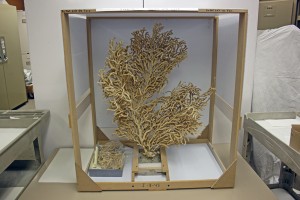
Carrlee says the process of having to look through every storage unit has helped the team locate what are called “registration problems” – items without a number.
“This museum goes back to 1900 so we’ve got 113 years of potential clerical errors,” she said.
But there’s also the chance of finding something that was missing, or two pieces that were separated.
“Right now I’ve got a bag that has a wing in it from a taxidermied bird and I know that through this process, I’m eventually going to find a bird with one wing and we’re going to reunite the bird with its wing,” Carrlee said.
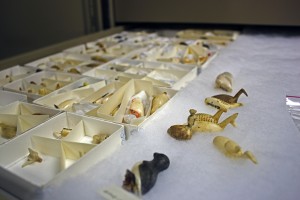
The team has until the end of February to pack up the museum’s collection. Once that’s all done safely and securely, Addison Field is in charge of moving the collection.
The majority of it will travel in carts through a tunnel to be built between the current building and the new one.
Field says other items, like paintings, may be hand carried.
“One object and one person and that’s not the most efficient way to do things, but when you’re dealing with things that are really truly treasures and need to be safeguarded, that’s the safest way to do it,” she said.
Certain items won’t fit through the tunnel, like the 8-foot wide, 45-foot long walrus hide umiak, which was originally assembled inside the building. Field doesn’t know how that will be moved, but he does know is when the doors of the new State Library Archives Museum opens in the spring of 2016, the umiak will be there unscathed.
Lisa Phu is a reporter at KTOO in Juneau.




